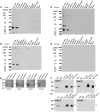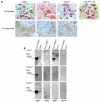Adult combined GH, prolactin, and TSH deficiency associated with circulating PIT-1 antibody in humans
- PMID: 21123951
- PMCID: PMC3007153
- DOI: 10.1172/JCI44073
Adult combined GH, prolactin, and TSH deficiency associated with circulating PIT-1 antibody in humans
Abstract
The pituitary-specific transcriptional factor-1 (PIT-1, also known as POU1F1), is an essential factor for multiple hormone-secreting cell types. A genetic defect in the PIT-1 gene results in congenital growth hormone (GH), prolactin (PRL), and thyroid-stimulating hormone (TSH) deficiency. Here, we investigated 3 cases of adult-onset combined GH, PRL, and TSH deficiencies and found that the endocrinological phenotype in each was linked to autoimmunity directed against the PIT-1 protein. We detected anti-PIT-1 antibody along with various autoantibodies in the patients' sera. An ELISA-based screening revealed that this antibody was highly specific to the disease and absent in control subjects. Immunohistochemical analysis revealed that PIT-1-, GH-, PRL-, and TSH-positive cells were absent in the pituitary of patient 2, who also had a range of autoimmune endocrinopathies. These clinical manifestations were compatible with the definition of autoimmune polyendocrine syndrome (APS). However, the main manifestations of APS-I--hypoparathyroidism and Candida infection--were not observed and the pituitary abnormalities were obviously different from the hypophysitis associated with APS. These data suggest that these patients define a unique "anti-PIT-1 antibody syndrome," related to APS.
Figures




References
Publication types
MeSH terms
Substances
LinkOut - more resources
Full Text Sources
Other Literature Sources
Research Materials
Miscellaneous

